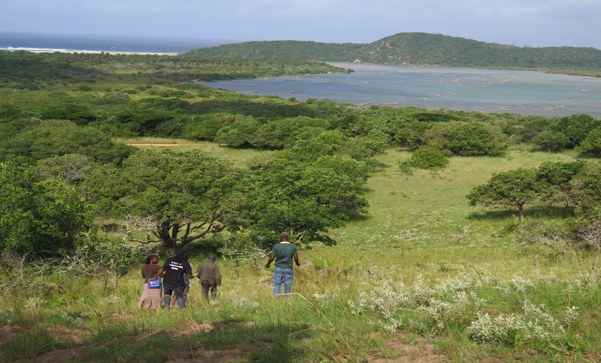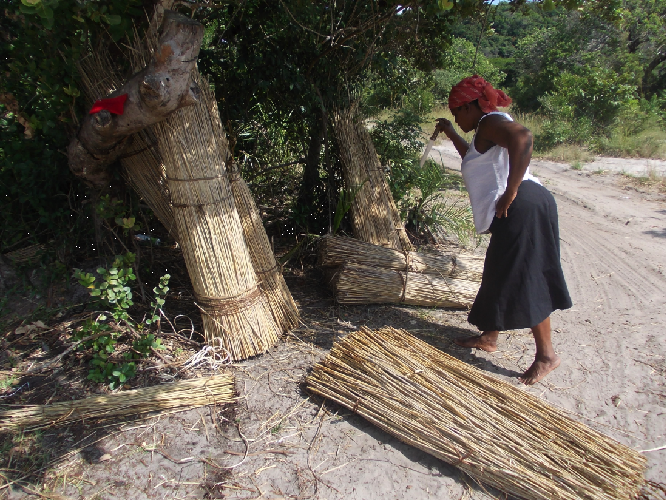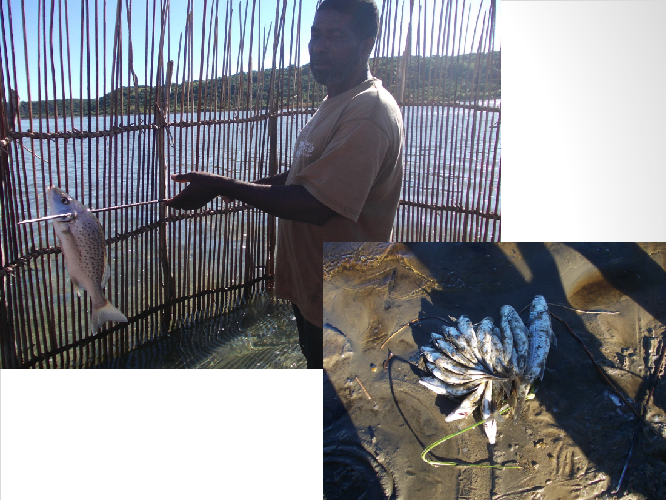
02 May Philile Mbatha – Kosi Bay, South Africa
“In the Spotlight” is a series of interviews that takes a closer look at the work of CCRN students and their research. Read more to learn about our students’ research and the communities they work with.

Philile Mbatha is a PhD Candidate and Assistant Lecturer in Environmental and Geographical Science Department, at the University of Cape Town, South Africa
CCRN student Philile Mbatha is a PhD Candidate and Assistant Lecturer in Environmental and Geographical Science Department, at the University Of Cape Town, South Africa. For her PhD thesis, supervised by CCRN member Merle Sowman, she is examining the role of multiple governance systems on coastal livelihood strategies. “I became interested in this field because I am passionate about research that bridges the gap between rural and marginalized communities and decision-making platforms for natural resource governance” says Philile. The CCRN has helped Philile connect to a wide network of researchers working on similar issues around the world.
Continue reading to learn more about Philile’s thesis “The influence of plural governance systems on coastal livelihood strategies: The case of Kosi Bay,” and the insights Philile gained while completing her PhD.
What is the topic you are addressing in your thesis?
This research has sought to elucidate understanding about rural coastal livelihood strategies by highlighting the manner through which rural livelihoods are shaped, influenced and reproduced by governance systems that aim to govern natural resources. For this undertaking, the study has drawn upon both on livelihoods and governance bodies of work in order to contribute towards building stronger linkages between livelihoods analyses and governance debates. One of the main reasons why this study is important is that it seeks to contribute to the gap in the body of knowledge about the relationship between the livelihoods strategies of rural and marginalized communities and plural natural resource governance systems controlling access and use of coastal resources. In the conceptual bodies of work within livelihoods and governance literature concerning natural resources, much of the emphasis is either on livelihoods or governance, respectively. There is limited literature, particularly in the southern African context, which examines the relationships or interactions between plural governance systems and rural livelihoods.
Kosi Bay is located within and adjacent to the iSimangaliso World Heritage Site, and is also located within the wider Maputaland region. It comprises a very ecologically unique lake system, which, because of its rich biodiversity, is part of an environment that is protected as a natural site under UNESCO World Heritage status. The iSimangaliso site was declared South Africa’s first World Heritage Site because its natural attributes are considered of global significance, as they have economic potential, and thus need to be conserved for both local people, as well as the international community. However, formal conservation within the boundaries of the iSimangaliso has existed for over 100 years, and the St. Lucia Nature Reserve is one of the oldest protected areas in Africa, established in 1895 (iSimangaliso Authority, 2011). The reasons for progressive creation of protected areas within the boundaries of iSimangaliso World Heritage Site is said to be motivated by the need for protecting increasing populations of large mammals such as hippopotamus, sea turtles, as well as black rhinoceros within the system (iSimangaliso Authority, 2016).
The iSimangaliso site was thus declared ‘world heritage’ as it met three of the ten criteria of UNESCO. The selection criteria provided by UNESCO (2015) are the main working tool for the selection of cultural and natural heritage globally are:
- To represent a masterpiece of human creative genius
- To exhibit an important interchange of human values, over a span of time or within a cultural area of the world, on developments in architecture or technology, monumental arts, town-planning or landscape design
- To bear a unique or at least exceptional testimony to a cultural tradition or to a civilization which is living or World which has disappeared
The Kosi Bay system within the iSimangaliso site consists of five unique ecological systems, i.e. dune forests, sandy beaches, rich tidal and coral reef zones, as well as grasslands (Guyot, 2005). The people who reside in the area weave their livelihoods around these resources, and engage in activities such as fisheries (in the lakes as well as on intertidal zones along the coast), forestry (i.e. harvesting indigenous forest products), eco- tourism and agriculture. In terms of coastal resource governance, the rural coastal community of Kosi Bay resides in the midst of a myriad of coastal activity (i.e. fishing, forestry and tourism) and governance arrangements for the Kosi Bay system. These include the UNESCO World Heritage Site, a Ramsar site, the Maputaland Marine Protected Area, the Tembe Coastal Forest Reserve, as well as the Ponta Do Ouro – Kosi Bay Trans-Frontier Conservation Area (TFCA). Moreover, statutory institutions for conservation governance operate parallel to traditional authority structures under Tembe Tribal Authority, as well as customary institutions that are long-standing within the area. There is also an existing land claim on World Heritage Site land by the members of the community that were historically forcibly removed for conservation during the apartheid era.
What excites you about the work you did for your thesis?
The work I did for my thesis excites me because the findings of my study will contribute towards the improvement of coastal governance in South Africa. Moreover, rural communities are empowered by the research in a manner that will assist them to challenge unjust decision-making processes.
Did you run into any difficulties during your studies? If so, how did you address them?
Yes I did. Kosi Bay is a highly contested area by the community and governance structures in relation to land and coastal resources. There is also an ongoing conflict between governance actors and members of the community around this, so much that the community was initially reluctant to speak to outsiders regarding these sensitive topics. However, the advantages I had were that I am from the Kwazulu-Natal province and therefore was able identify with the culture of the local people and also speak the local language. This assisted me to quickly establish a positive relationship as a researcher with community members when the study was introduced, and it enabled me to gain the trust of the local people. Earning the trust of people in Kosi Bay was not initially easy, as the people in the three communities have, over the years, become very skeptical of researchers coming into the area to elicit information without ever returning to provide positive feedback about the research to the local people. Moreover, people in the villages have also become distrustful towards researchers over the years as they expressed that they feel that ‘research’ has betrayed them in the past and is the reason why they lost their security and livelihoods. In order to overcome these, I had to conduct various meetings with community members before commencing with my research. This ensured that the people were satisfied with the understanding of the research in order to allow it to proceed.
How will your research affect the community you worked with?
When the research is done, the results will be fed back to the community so that they can use it to empower themselves and challenge current governance systems. A policy brief from the research findings will also be published in order to raise awareness and engage decision-makers on issues affecting livelihoods of rural communities affected by protected areas.
What do you think are the next steps for learning more about the topics you addressed in your thesis?
The next step will be to engage organizations like UNESCO and other actors in the international community about how global policy regimes for environmental protection are translated in developing countries, and how they alter or shift the livelihood strategies of marginalized communities. More research needs to be done to assess the influence of international policy regimes for protecting natural resources on local livelihood strategies.
How does your research contribute to your field?
My research will contribute to the theoretical gaps within the livelihoods body of work by exploring the interface between livelihoods and governance debates, in relation to natural resource governance.
References
Guyot, S. 2005. Political dimensions of environmental conflicts in Kosi Bay (South Africa). Signification of the new post-apartheid governance system. Development Southern Africa, Vol. 32(3).
ISimangaliso Authority. 2011. ISimangaliso Wetland Park Wetland Park IntegratedManagement Plan (2011-2016). St. Lucia, KwaZulu-Natal, South Africa. Online [Available].
isimangaliso.com/product/isimangaliso-imp-2011-2016/
ISimangaliso Authority. 2016. ISimangaliso Wetland Park Wetland Park Integrated Management Plan (2017-2021). St. Lucia, KwaZulu-Natal, South Africa. Online [Available].
isimangaliso.com/product/isimangaliso-imp-2017-2021/
United Nations Educational, Scientific and Cultural Organization (UNESCO), 2015. Operational Guidelines for the Implementation of the World Heritage Convention. World Heritage Centre, France: Paris.




